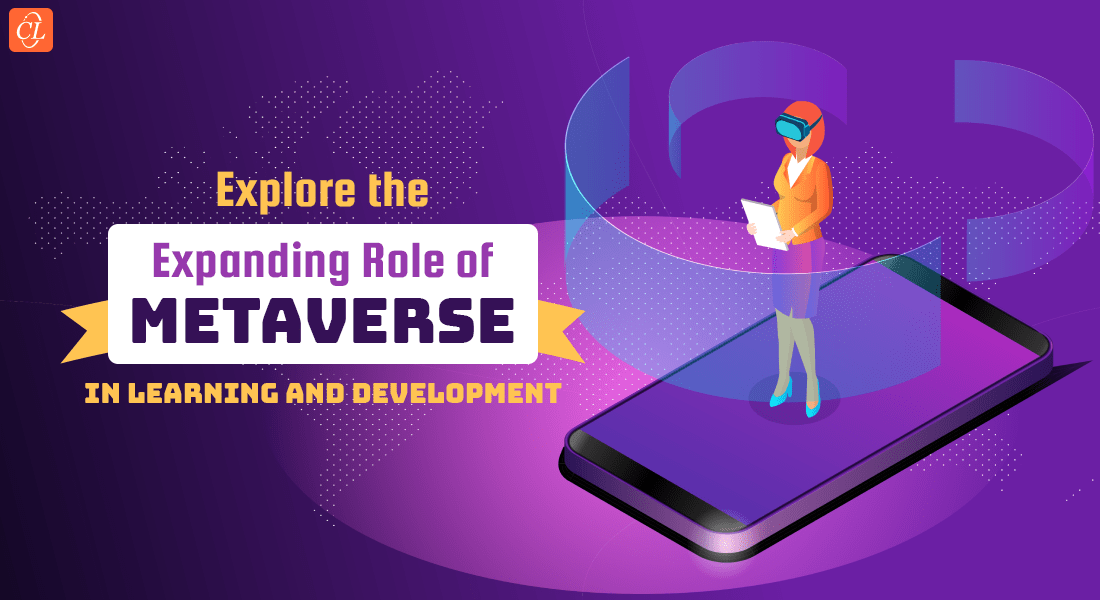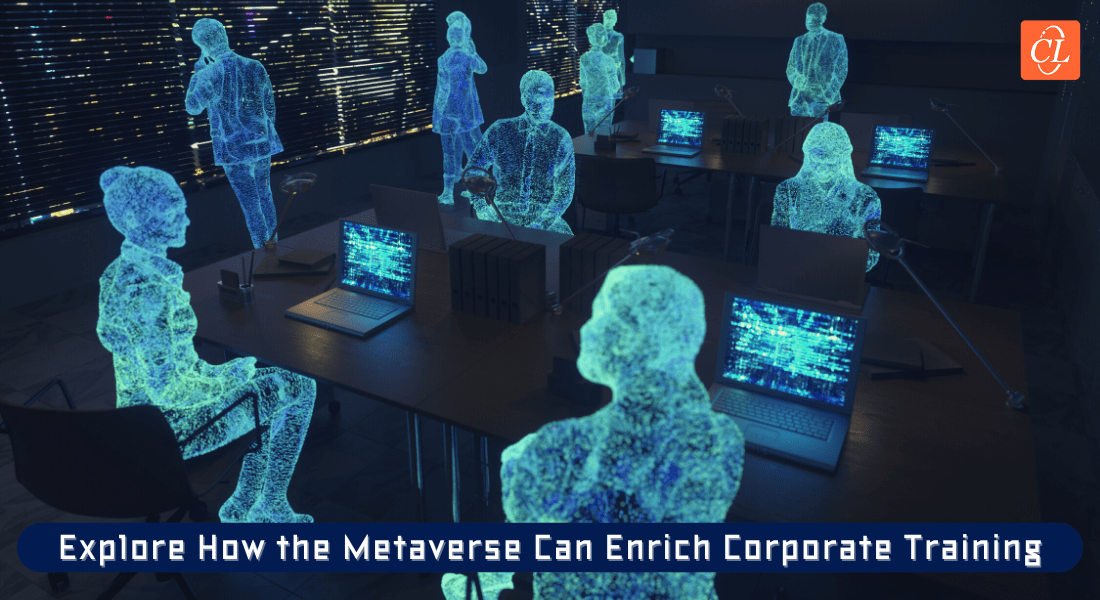How does the Metaverse Revamp the Corporate Training Game?

The metaverse is making its way into everyday conversations on the web, in pop culture, in the mainstream news media, as well as behind closed-door corporate discussions about whether—and how—to be an early user of this medium. Its discovery leads to a defining moment that will fundamentally alter our technical and cultural assumptions.
Humanity has transitioned from mechanical and analogue electronics to digital formats in a very short span of time. The astounding number of digital advancements has led us to where this technology has permeated almost every aspect of our lives. The metaverse is the most recent innovation that everyone is talking about.
Are You Eager to Know About the Technologies That Empower the Metaverse?
Here they are:
- Virtual Reality
- Augmented Reality
- Non-Fungible Tokens (NFTs)
What is the Metaverse?
Neal Stephenson introduced the word “metaverse” in his science fiction novel “Snow Crash.” This novel depicts the internet’s future and its transformation into an alternative digital realm. Many tech titans have expanded on this concept to build a true metaverse that encompasses AR (augmented reality), VR (virtual reality), 3D holographics, blockchain, and other digital communication channels.
Everyone is wondering what the future will hold for Facebook after its rebranding into Meta and Mark Zuckerberg’s speech on the next generation of the internet. Mark Zuckerberg’s aim for the metaverse is to build a digital environment that combines the virtual and physical worlds so that people can interact, play, socialize, and collaborate.
Microsoft, Epic Games, and Nvidia are investing resources towards bringing this virtual world to life. AR and VR are two crucial technologies that play a significant role in making the Metaverse a reality.
Although the metaverse has many applications, in this blog, we will look at how it can transform the face of corporate training.
Explore how rapid eLearning can aid in quick deployment, whether it’s immersive learning or game-based courses.
What Role Does the Metaverse Play in eLearning?
During the last ten years, the learning and development sector has adopted technologies such as virtual reality and augmented reality to complement its training programs. Remote training has become a priority owing to the pandemic, and technology has become the foundation for work, onboarding and training from remote locations.
By providing a one-stop shop for immersive learning, training in the metaverse can catalyze the shift to working remotely. Existing technology is bringing the metaverse closer to becoming a reality, providing it with economic value. Meta has invested 10 billion dollars in wearable virtual reality and augmented reality gadgets.
VR and AR provide new and dynamic engagement tools to operate in the metaverse. They enable learners to comprehend more swiftly, retain information more effectively, and enjoy the learning process. According to a PWC study, employees who are trained using VR simulations learn four times faster than conventional classroom learners.
Now that we’ve established the significance of the metaverse to the eLearning space, let’s look at the technologies that enable it.
Technologies Empowering the Metaverse
The two primary technologies that play a vital part in turning the metaverse into a genuine, operational place are augmented reality and virtual reality. This is how they’re altering the game.
Virtual Reality
Learners may now connect with each other and their learning programs more easily thanks to technological advancements. Virtual Reality has immersed learners into inventive and breath-taking environments, facilitating a variety of effective learning experiences in both technical and soft skills training. Here are a few instances:
- A doctor learns how to save someone’s life who has had a seizure or is in anaphylactic shock using an immersive VR simulation. In this instance, the advantage f adopting virtual reality is that it is safe to learn by making mistakes – the doctor’s performance can be tracked and analysed to see where real-life improvements could be made.
- Employees feel better equipped to handle customers’ demands from Day 1 after completing a VR onboarding exercise. Before setting foot behind their own store counter, learners can practice processing returns, answering questions about products, and dealing with upset clients. This VR enabled activity allows learners to sharpen their customer service abilities without jeopardizing their company’s image.
- Employee retention and productivity are more likely to suffer if an organization has an inefficient onboarding procedure. VR has the potential to greatly improve this procedure, making it more efficient and fun. Before they even set foot in the office, when participating in a VR enabled onboarding activity, new employees can get an introduction to the firm, take a tour of the facility, have a look at different business locations, and meet their manager – all from the comfort of their own home.
The storytelling technique can greatly enhance learners’ interest when they engage in training. In the same way that video games create a narrative and allow players to interact with them, training programs can use VR to boost the performance of the workforce. VR empowered training can be implemented in every place where corporate training is required.
Augmented Reality
By superimposing digital assets onto a learner’s phone or wearable device, such as AR-enabled headsets, augmented reality (AR) offers access to critical information.
AR can be used to give on-the-job training to enhance employee skills and career growth. By aiming their phone’s camera at any product, sales staff can instantly research technical specs and determine if their products are in stock. Employees can use AR to learn about a new product, engage with it, and acquire product expertise if their firm doesn’t have the means to distribute product samples.
Non-Fungible Tokens (NFTs)
An NFT is a data unit that is kept on a non-editable digital ledger that is accessible over a worldwide network of computers. NFTs are distinct from other blockchain technologies such as Bitcoin in that each token on the NFT blockchain is one-of-a-kind. Interestingly, “NFT” is Collins Dictionary’s word of the year for 2021.
If something is fungible, it can be readily exchanged for something else. A nonfungible token, on the other hand, has an owner and can be sold or transferred, but it is not fungible. As a result, it might be used to exchange digital assets such as trading cards, Kickstarter supporter badges, and digital celebrity autographs. There is no intrinsic worth of an NFT; its value comes from the fact that others want what you have.
Here are Some of the Ways NFTs & Blockchain Technology Can be Leveraged in L&D.
- Blockchain’s immutability makes it ideal for storing permanent records. This might be a game-changer for L & D enthusiasts looking to provide training. For example: Consider a linked network of qualifications that can be simply allocated to a user with extra information such as a level, a completion date, and a final score.
- NFTs have the capacity to establish a sense of community, giving participants a large community that can help them progress in their learning.
It’s not a stretch to call NFTs a promising, digitally forward technology. However, its frequently used in the fields of art and sports, while other industries are overlooked for wanting to aim high and push the boundaries of technology. NFTs have the potential to radically transform the L&D space, bringing in a new and more ambitious learning environment for both learners and instructors.
Why is Metaverse Training so Important Now, More Than Ever?
The metaverse has the potential to bring together all the benefits of VR and AR into a singular and authentic experience. Learners can search for information about a particular product, look up background material, virtually control items, role play, and conduct one-on-one dialogues using the metaverse.
As a result of the pandemic, all organizations have embraced digital solutions to facilitate team communication and training from their locations remotely. It’s no surprise then that the metaverse has piqued everyone’s interest as a possible medium of the future.
Hybrid workspaces have grown in popularity in recent years as more businesses have started to adopt this model. Employees are becoming increasingly discontent with video conferencing as their primary means of communication and collaboration. As the prevalence of eLearning skyrockets, immersive technologies, such as the metaverse, are seeing a significant rise in implementation. These types of automation provide learners with a richer sense of “being there” while maintaining a safe distance, as well as a way of connecting the global workforce.
Parting Thoughts!
As people spend more time on the internet and their identities become intertwined with their lives online, the metaverse is anticipated to grow and take root. This avant-garde technology has the power to transport learners back in time and into different environments. Training managers and L&D enthusiasts will benefit from the use of such a technology because it can result in improved learning and greater enrolment. It will take at least a decade for the eLearning industry to be transformed by the Metaverse.
eLearning courses are already a major force in the corporate world. Incorporating VR and AR into eLearning apps will help us get even closer to a 360-degree transformation in how training is done. Like the internet, the metaverse will most certainly advance and become a part of our everyday lives.
While the emphasis of this blog was the Metaverse, are you aware of any current or emerging eLearning trends that will continue to dominate the future? If you want to learn more about the impact that eLearning is making, check out our eBook titled “eLearning Trends 2022.” If you’re a training manager or a member of the L&D community, don’t miss out on discovering what’s all the rage in corporate training!





